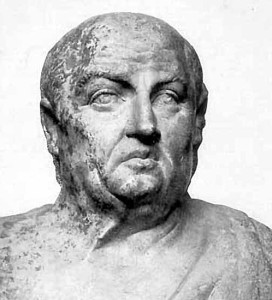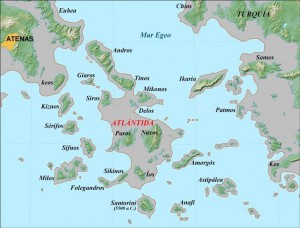Gibraltar landbridge
Sarkar, Pabhat Rainjan (L)
 Pabhat Rainjan Sarkar (1921-1990) was an Indian philosopher and spiritual leader with followers in over 130 countries. I am reliably informed that he expressed a number of beliefs regarding Atlantis, the core of which was that it was a huge continent that existed in the Atlantic. He also believed that Atlantis joined Africa and Iberia with a landbridge at Gibraltar. The destruction of Atlantis by an extensive earthquake separated Europe from Africa and also led to the creation of the Sahara.
Pabhat Rainjan Sarkar (1921-1990) was an Indian philosopher and spiritual leader with followers in over 130 countries. I am reliably informed that he expressed a number of beliefs regarding Atlantis, the core of which was that it was a huge continent that existed in the Atlantic. He also believed that Atlantis joined Africa and Iberia with a landbridge at Gibraltar. The destruction of Atlantis by an extensive earthquake separated Europe from Africa and also led to the creation of the Sahara.
In the book, Travels with the Mystic Master(a) by Dada Dharmavedananda, Sarkar is quoted as saying that ” The old Atlantis is now underwater except for parts of Spain, Portugal, Ireland and Iceland.”[1209.208]
(a) https://www.scribd.com/doc/11386818/Travels-With-the-Mystic-Master
Seneca
 Seneca (the Younger) (c. 4 BC-65 AD) was a Roman philosopher, statesman and dramatist. In one of his tragedies, Hercules Furens, he refers to the breaching of the Gibraltar landbridge and the influx of the Atlantic into the Mediterranean – “he clove the mountains on either hand and, rending the barrier, made a wide path for Ocean’s rushing stream.” (trans. F.J. Miller)[1352.v220]
Seneca (the Younger) (c. 4 BC-65 AD) was a Roman philosopher, statesman and dramatist. In one of his tragedies, Hercules Furens, he refers to the breaching of the Gibraltar landbridge and the influx of the Atlantic into the Mediterranean – “he clove the mountains on either hand and, rending the barrier, made a wide path for Ocean’s rushing stream.” (trans. F.J. Miller)[1352.v220]
Hamer, Colin
Colin Hamer or to give him his full title “His Benevolence, The Extra-Reverend Doctor Colin James Hamer” is the author of the ‘beautytruegood’ website(a). The site  ranges over a vast collection of subjects, many relating to a religious or historical matter.
ranges over a vast collection of subjects, many relating to a religious or historical matter.
Hamer was a friend of the late Joseph S. Ellul and frequently visited him in Malta. He shared Ellul’s idea that Malta had been part of Atlantis, which had been inundated when the Gibraltar landbridge broke and the Mediterranean was flooded. An event they believed was recorded as Noah’s Flood.
Hamer is inclined to wander all over the place, but there are a few nuggets to be unearthed including excerpts from Ellul’s work, which is no longer available in English.
(a) https://web.archive.org/web/20141116190825/https://beautytruegood.co.uk/jdspluv1.htm
Recuenco Andrés, Javier
Javier Recuenco Andrés (1973- ) is an IT engineer from Cadiz in Spain. He has a passion for chess, history and mythology. His interest in the latter has led to his publication of a heavily illustrated The Historical Reality of  Atlantis in Spanish and English (Kindle only).
Atlantis in Spanish and English (Kindle only).
He begins with an in-depth examination of a ‘Tartessian’ gold disk that led on to an etymological investigation of the ‘K-N’ inscription on it, which he believes referred to the Conii people who settled in what is now southern Portugal. He speculates that the design of the disk reflects the layout of the acropolis of Atlantis! He has suggested that this acropolis was probably located in the vicinity of the Canary Islands.
In 2013, Recuenco Andrés and Diaz-Montexano jointly published a paper(a) on the academia.edu website offering comparable interpretations of the disk with the same conclusion that it was connected with Atlantis.
Javier dates the foundation of Atlantis to a period between 21,000 and 12,000 BC. Andrés has a hyperdiffusionist view of Atlantis showing rock carvings in North Africa, America, Australia, China and of course his native Iberia as evidence for their global influence. The fall of the Atlantean ‘Empire’ he suggests was between 12,000 and 9,000 BC, as the last Ice Age was ending.
He subscribes to the idea that there was a Gibraltar landbridge, which was breached around 5,500 BC that eventually led to the linking of the Mediterranean and the Black Sea, an event originally revealed by Ryan & Pitman.
Javier also believes that Egypt was occupied by Atlanteans from 7000–5500 BC, but that their influence led to the building of the pyramids! In fact, he attributes the pyramids of China and America to Atlantean influence. He identifies Knossos in Crete as an Atlantean colony in the eastern Mediterranean.
In my opinion, Javier has produced an original work, unlike the regurgitated offerings of so many others. Nevertheless, I think his work has too many assumptions based on excusable subjectivity.
Sánchez de Ocaña, Manuel
Manuel Sánchez de Ocaña (1859-1937) was the Spanish Lieutenant General  during the 1909 war in Africa. In a rare 1935 book, Accion de España en Africa(a) (Spanish Action in Africa) he refers to the ancient isthmus that linked Spain and North Africa as well as landbridges linking Europe and America on which he believed Atlantis had been situated.
during the 1909 war in Africa. In a rare 1935 book, Accion de España en Africa(a) (Spanish Action in Africa) he refers to the ancient isthmus that linked Spain and North Africa as well as landbridges linking Europe and America on which he believed Atlantis had been situated.
(a) See : https://web.archive.org/web/20160418135547/https://www.alconet.com.ar/varios/mitologia/griega/mito13.html (Spanish)
Thayer Ojeda, Luis (L)
 Luis Thayer Ojeda (1874-1942) was a Chilean historian, linguist and keen euhemerist. He spent a long time studying Mediterranean mythologies and concluded that classical mythology is nothing more than a poetic form of a nation’s history. He believed that many of the peoples of Europe, conventionally assumed to have arrived from the east, had in fact come from the west – from Atlantis. Thayer Ojeda also supported the concept of an isthmus at Gibraltar and produced a hypothetical map of the Mediterranean before the breaching of the landbridge. Alexander Braghine wrote enthusiastically about Thayer Ojeda’s work[156.144/7], recommending two of his books, which unfortunately are only available in Spanish.
Luis Thayer Ojeda (1874-1942) was a Chilean historian, linguist and keen euhemerist. He spent a long time studying Mediterranean mythologies and concluded that classical mythology is nothing more than a poetic form of a nation’s history. He believed that many of the peoples of Europe, conventionally assumed to have arrived from the east, had in fact come from the west – from Atlantis. Thayer Ojeda also supported the concept of an isthmus at Gibraltar and produced a hypothetical map of the Mediterranean before the breaching of the landbridge. Alexander Braghine wrote enthusiastically about Thayer Ojeda’s work[156.144/7], recommending two of his books, which unfortunately are only available in Spanish.
Rafinesque, Constantine Samuel
 Constantine Samuel Rafinesque (1783-1840) was born in Constantinople of mixed French/German parentage. He was a polymath with advanced ideas in a range of disciplines with a special interest in pre-Columbian America. He was one of the first to partially decipher the Mayan numbering system. He did not exclude Atlantis from his wide-ranging studies and claimed that the various Atlantic islands, such as Azores, Canarias, Madeira etc., were part of Atlantis, he also included the Americas which he referred to as ‘Megalantodos’ or the ‘Great Atlantis He also advocated that the 9,000 years that Plato/Solon said had elapsed since the demise of Atlantis should be read as seasons of which there were three in the Egyptian solar year.
Constantine Samuel Rafinesque (1783-1840) was born in Constantinople of mixed French/German parentage. He was a polymath with advanced ideas in a range of disciplines with a special interest in pre-Columbian America. He was one of the first to partially decipher the Mayan numbering system. He did not exclude Atlantis from his wide-ranging studies and claimed that the various Atlantic islands, such as Azores, Canarias, Madeira etc., were part of Atlantis, he also included the Americas which he referred to as ‘Megalantodos’ or the ‘Great Atlantis He also advocated that the 9,000 years that Plato/Solon said had elapsed since the demise of Atlantis should be read as seasons of which there were three in the Egyptian solar year.
He further claimed that there was a Gibraltar landbridge that was destroyed 654 years after Noah’s Flood. These claims are to be found on page 232 of Vol II of The American Nations published in 1836. This volume can now be read online(a).
Zamarro, Paulino
Paulino Zamarro, born in 1947, in Cantalejo, Segovia, Spain and is now living  in Madrid. He is an industrial engineer specialising in chemistry and has worked for over twenty years on environmental studies. Among his ecological publications, in Spanish, is a monograph on a wetland near his birthplace – The Lagoons of Catalejo.
in Madrid. He is an industrial engineer specialising in chemistry and has worked for over twenty years on environmental studies. Among his ecological publications, in Spanish, is a monograph on a wetland near his birthplace – The Lagoons of Catalejo.
He is also the author of Del Estrecho de Gibraltar a la Atlantida (From the Strait of Gibraltar to Atlantis)[0024], in which he puts forward a number of radical ideas. He first proposes that an isthmus at the Strait of Gibraltar had been created as a result of silting. He then claims that at the end of the last Ice Age this landbridge was breached leading to the destruction of Atlantis. Both Strato and Seneca refer to the breaking of the Gibraltar dam. Zamarro dates the breach to circa 5500 BC.
He places Atlantis in the Cyclades in the Eastern Mediterranean, which had originally been a single landmass and identifies a tiny island called Pori north of the island of Antikythera as the site of the Pillars of Heracles. Fifteen years later Christos A. Djonis proposed a location in the same region without giving any credit to Zamarro. He highlighted the multiplicity of locations that have been designated as the site of the ‘Pillars’.
 To-date the book has only been published in Spanish, although Zamarro is anxious to have it published in English. His ideas are summarised on a website(a) promoting the book, which can be translated by your browser.
To-date the book has only been published in Spanish, although Zamarro is anxious to have it published in English. His ideas are summarised on a website(a) promoting the book, which can be translated by your browser.
Zamarro has recently added a further site(b) where the first 100 pages of his book (in Spanish) can be read online. A revised second edition of his book was published in 2012 with the slightly shortened title of De Gibraltar a la Atlántida and also available in the Kindle format.
>March 4th 2021 saw Pablo Rodríguez Cantos publish a review(c) (in Spanish) of Zamarro’s book, which can be read in English here.<
(a) https://atlantida.webatu.com/ (offline July 2016) See: https://web.archive.org/web/20130528153632/https://atlantida.webatu.com/
(b) https://www.atlantidaegeo.com/ (link broken Jan. 2019) See: https://web.archive.org/web/20180806011857/https://www.atlantidaegeo.com
Ellul, Joseph S.
Joseph S. Ellul (1920-2011) was a retired Maltese schoolteacher, who lived in Zurrieq near the ancient temple of Hagar Qim. As an amateur archaeologist he  was of the opinion that Malta was part of Atlantis and that it was Noah’s Flood that inundated many of Malta’s prehistoric monuments, some of which are still submerged. Ellul’s family had been caretakers of the nearby ruins of Hagar Qim for many years, so he rightly claimed to have an intimate knowledge of the monument. He, together with Paulino Zamarro shared the idea that the collapse of a land bridge between Gibraltar and Morocco caused extensive flooding in the Mediterranean.
was of the opinion that Malta was part of Atlantis and that it was Noah’s Flood that inundated many of Malta’s prehistoric monuments, some of which are still submerged. Ellul’s family had been caretakers of the nearby ruins of Hagar Qim for many years, so he rightly claimed to have an intimate knowledge of the monument. He, together with Paulino Zamarro shared the idea that the collapse of a land bridge between Gibraltar and Morocco caused extensive flooding in the Mediterranean.
Ellul related how the megalithic ruins of Hagar Qim were once dated to around 10000 BC by a British archaeologist, whom he surmised to be the renowned V. Gordon Childe. In his book[289] Ellul put forward his argument for a catastrophic flood originating in the western Mediterranean and being of such speed and size that it caused severe damage to Hagar Qim. Since the temple is over 400 feet above sea level he concludes that this must have been the result of the breaching of an isthmus in the region of Gibraltar.
Ellul has also argued in a letter to The Malta Independent (7/10/2002) that the Hagar Qim temple incorporated a number of astronomical alignments(c). A number of attempts have been made to link the orientation of the temples with various astronomical bodies. A limited study by John Cox proposed a connection with moonrise(d). Mario Vassallo favours an association with the winter solstice sunrise(e). Klaus Albrecht also identifies [1632] the winter solstice sunrise as his preferred orientation(f). Lenie Reedijk offers [1631] a far more radical explanation for the alignment of all the temples, namely that they were directed at Sirius, the brightest star in the night sky at that time.
The only other possible cause might be a giant tsunami, which I have never heard suggested by anyone, although Charles Savona Ventura has written of a tsunami that was observed on Gozo in 1692 following a destructive earthquake, which are rare in the area. The sea receded about one mile before rushing back to add to the seismic damage. Unfortunately the height of the tsunami is not recorded but would have far less than the 130 meters of Hagar Qim.
Even if there had been no such land bridge, the lowering of sea levels with the onset of the last Ice Age would undoubtedly have resulted in Malta having a more extensive landmass that would have been flooded by the subsequent melting of the glaciers but not in the catastrophic manner indicated by the physical evidence.
Excerpts from Ellul’s book are available in English on the Internet(a). His opinions regarding Malta’s cart-ruts are of interest, if somewhat controversial, and can also be read online (b).
Sadly, Joseph died in the early hours of March 28th 2011.
(a) MEDITERRANEAN BASIN CATASTROPHE/ MALTA’S PREHISTORIC GENIUS … Page 16 (archive.org) or See: Archive 2814
(b) https://web.archive.org/web/20050301092052/https://www.truegood.fsnet.co.uk/hagarq5.htm
(c) https://web.archive.org/web/20190112182925/https://www.ancient-wisdom.com/maltahagarqim.htm
(d) https://academic.oup.com/astrogeo/article/49/1/1.7/307209
(e) ‘The Location of the Maltese Neolithic Temple Sites’, Sunday Times, 26 August 2007, pp. 44–46.
(f) https://www.geestkunde.net/tabula-smaragdina/malta-tempels-aardgodin.shtml
Wingate, Richard
Richard Wingate (1933-2011) was described by Andrew Collins as a ‘maverick mineral  prospector and explorer’(a). His search for Atlantis brought him to Ecuador where he was enchanted by the so-called Crespi Collection leading him to speculate on a possible link between it and lost Atlantis. He subsequently shifted his attention to the Bahamas where he claimed to have discovered Atlantean structures in shallow waters. He detailed his discoveries in his first book[059].
prospector and explorer’(a). His search for Atlantis brought him to Ecuador where he was enchanted by the so-called Crespi Collection leading him to speculate on a possible link between it and lost Atlantis. He subsequently shifted his attention to the Bahamas where he claimed to have discovered Atlantean structures in shallow waters. He detailed his discoveries in his first book[059].
Wingate published his second book, Atlantis in the Amazon[771] in June 2011. In it he returned to a further consideration of the Crespi Collection and its place in the theory of a South American/Caribbean Atlantis. In support of his view of Atlantis he invoked the controversial Oera Linda Book, Annie Besant, the English theosophist and of course Edgar Cayce.
He also discussed ‘ancient technologies’, including his most startling claim, that Atlantis was destroyed by a prehistoric nuclear war between the Aryans and the Atlanteans. He speculates that the Athenian army was destroyed when a Gibraltar landbridge was shattered by earthquakes allowing the Atlantic to flow in, swamping the Hellenes! Minor details overlooked by Plato!
Wingate originally put Atlantis in the Bahamas, but now he entitled his second book as Atlantis in the Amazon and ends up with Atlanteans being involved in nuclear war in ancient India. Along the way we have metallic glue, Easter Island, Indian wooden flying machines and ancient lasers. All very confusing, to say the least.
Wingate’s ancient atomic weapons claim is just a rehash of the wild speculation from the 1940’s(e) followed by that of Pauwels and Bergier in the 1960’s and regularly regurgitated ever since(b). Contrast the last link and Wingate’s remarks with the more forensic analysis of Jason Colavito(c) together with Dale Drinnon’s account(d).>The late Philip Coppens also wrote a fairly balanced article(f) on the subject ancient nuclear weaponry.<
(a) https://www.andrewcollins.com/page/articles/stones.htm
(b) https://www.allvoices.com/contributed-news/5923291-atlantis-destroyed-from-atomic-bombing-by-rama-a-deep-study (offline July 2015)
(c) https://www.jasoncolavito.com/the-case-of-the-false-quotes.html
(d) See: Archive 2324
>(f) https://web.archive.org/web/20200225034114/https://www.eyeofthepsychic.com/bestevidence/<
